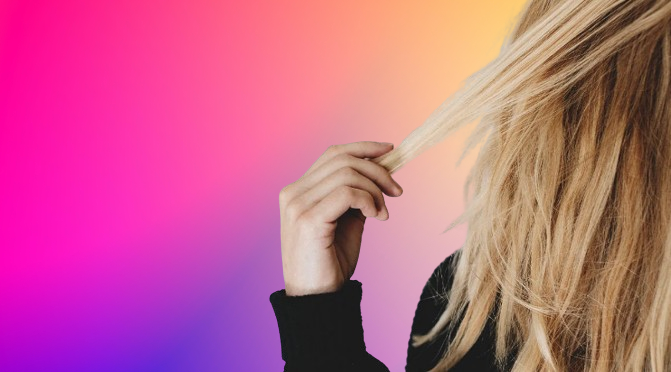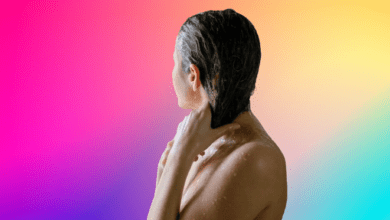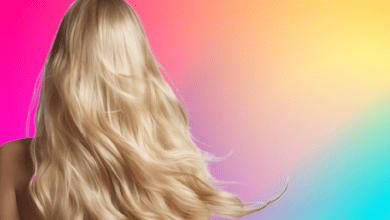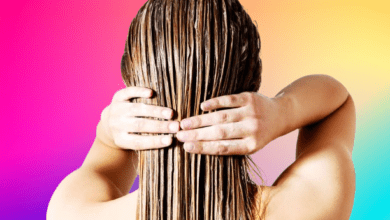11 Tips on How to Fix Damaged Hair

A head full of damaged hair is the number one way to ruin your chances of having a great hair day. In actuality, damaged hair needs extra attention in order to feel and look smooth and healthy. Therefore, it’s critical that you understand how to repair damaged hair using a proper hair care routine if you find yourself dealing with dry strands, brittle hair, and split ends as a result of heat damage, hair color, or frequent bleaching. The greatest shampoo for damaged hair and other products, along with advice on how to repair hair damage, are all included below.
Why Does Damaged Hair Occur?
Damaged strands can result from various factors, most often from a confluence of them. These are the top three reasons why hair gets damaged.
1. Discoloration
The American Academy of Dermatology (AAD) states that lightening hair more than three shades lightens it and necessitates larger amounts of peroxide or bleach, both of which increase the risk of hair damage. Dryness results from bleaching the hair, and frequent bleaching can cause more severe damage like split ends and breakage.
2. Hot-Style
Although we adore hot tools for creating in-vogue looks like a voluminous blowout, frequent use of them can be detrimental to our hair. Our hot tools can frequently achieve temperatures higher than those we typically use to cook food, which can severely fry your hair strands. It’s okay to use them occasionally, but you should always use them in conjunction with good hair habits, such as applying heat protectant and using the lowest temperature possible.
3. Color of Hair
Additionally, permanent hair color can dry out your strands, causing damage like dehydration and brittle hair. It is therefore recommended to give your hair six to eight weeks—or more—to repair in between hair color appointments. The AAD also suggests choosing a darker shade than your current hair color because it prevents bleaching and is less harsh on your hair.
Is Hair Damage Reparable?
Healthy hair habits, such as masking and avoiding heat and brushing, can help restore damaged hair to some extent. However, in order to stop the breakage from spreading further up your hair, it’s best to get a haircut and start over if your hair has already started to break off.
How Can Severe Hair Damage Be Fixed?
You have to take extra care when taking care of hair that is severely damaged. Steer clear of bleaching, hair color, and all forms of heat if you’re attempting to heal your hair. Washing your hair too frequently can cause dryness and further damage to your hair, so it’s best to wash damaged hair no more than twice a week.
It’s crucial that you include a protein treatment in your routine, such as the L’Oréal Paris Elvive Total Repair 5 Power Restore Multi-Use Treatment. Apply it as a leave-in treatment to strengthen weak hair fibers or in place of conditioner. Because a protein concentrate leaves hair feeling silky and healthy-looking while strengthening it, it is beneficial for damaged hair.
How to Handle Damaged Hair
There are a few ways you can take care of your hair to repair the damage that has already occurred and prevent more damage, even though you might believe that getting a haircut is the only way to restore your damaged hair. These are 11 suggestions for mending broken threads.
1. For damaged hair, use shampoo and conditioner.
Choosing a hair care system that was designed specifically for damaged hair is the first step towards having healthy hair. Because they reinforce weak hair bonds and strengthen hair from the inside out, we adore the L’Oréal Paris EverPure Sulfate-Free Bond Repair Pre-Shampoo Treatment, L’Oréal Paris EverPure Sulfate-Free Bond Repair Shampoo with Citric Acid, and L’Oréal Paris EverPure Sulfate-Free Bond Repair Conditioner with Citric Acid.
In order to strengthen weak hair bonds and protect hair from further damage from styling and coloring, the trio uses citric acid. Before shampooing and conditioning your hair, apply the pre-shampoo treatment and let it sit for five to ten minutes.
2. Use Lukewarm Water to Wash Your Hair
Although taking a hot, steamy shower feels wonderful for your skin, the heat can be very damaging to your hair, particularly if you have damaged strands. Extremely hot water depletes your hair of essential oils, which can prematurely fade your hair color and make your hair feel even drier.
Therefore, the next time you wash your hair, turn down the heat and rinse it with lukewarm water. It’s much better for your hair, even though it might not be as luxurious.
3. Apply a Treatment for Deep Conditioning
It’s time to incorporate a deep conditioner into your weekly hair care regimen if you haven’t already. Treatments for deep conditioning focus on typical indicators of damaged hair, such as breakage, split ends, and dryness. In addition, a lot of deep conditioning treatments include collagen peptides and other nourishing ingredients that strengthen hair and shield it from further damage. In just three to five minutes, damaged hair can be restored and conditioned with the help of the L’Oréal Paris Elvive Total Repair 5 Damage Erasing Balm Rinse-Out Mask, which is made with nourishing ingredients like hydrating almond oil and a protein-rich repair concentrate.
4. Use a Wide Tooth Comb Instead of a Hairbrush
Serious hair breakage can result from tangles and the vigorous tugging motions of a hairbrush. This is especially true for wet hair, but it also applies to dry hair. Wet hair is the most delicate and therefore most prone to damage, according to the AAD. For this reason, when your hair is wet, it is best to use a wide tooth comb because the large gaps between the teeth will smooth your hair more easily and with less tugging and friction.
To make combing your hair easier when it’s wet, remove any knots that may have formed in your hair before shampooing. Smoothing and detangling hair are just two of the many benefits of the nourishing L’Oréal Paris EverPure Sulfate-Free 21-in-1 Color Caring Spray, Leave In. Before combing, spritz it on damp or dry hair to get rid of tangles.
5. Use a T-shirt to Dry Your Hair
Use your old, faded t-shirts to plop your hair when you get out of the shower rather than throwing them away. Using a terry cloth towel to vigorously rub your hair dry can cause harsh tugging, which can cause breakage even with healthy hair.
Because cotton tees are absorbent and much kinder to hair than towels, they work well. Recall that the key to taking care of damaged hair is to be gentle. A microfiber towel is an excellent substitute that can be used to quickly absorb moisture and dry hair without causing tugging.
6. Use a leave-in conditioner.
After washing your hair, using a hydrating leave-in conditioner can help to seal split ends, minimize frizz, and make your hair feel and look softer and easier to manage. The lightweight, creamy formula of the L’Oréal Paris Elvive Total Repair 5 Protein Recharge Leave-In Conditioner Treatment smoothes the appearance of damage and functions as a heat protectant, making it a great option.
Consider using the L’Oréal Paris Elvive Dream Lengths Curls Non-Stop Dreamy Curls Leave-In Conditioner if you have curls. It hydrates hair and minimizes frizz without making it feel heavy.
7. Use heat protector at all times
Always use heat protectant on your hair before starting to create your sleek blowout or voluminous curls. Irrespective of your hair type, this ought to be the initial step in the heat styling process, particularly if you exhibit any indications of hair damage. To smooth and shield wet hair, try the L’Oréal Paris EverPure Sulfate-Free Weightless Blow Dry Primer, Heat Protectant; for dry hair, try the L’Oréal Paris Elvive Dream Lengths Frizz Killer Serum Leave-In, which reduces frizz.
8. Try Out These Heatless Hairstyles
Although using heat protectant is essential, you should completely refrain from using heat on severely damaged hair; you won’t regret it. Choosing heatless hairstyles or embracing your natural hair texture are two excellent ways to spare your strands from hot tools, which are a major source of damage.
Use a leave-in treatment that enhances curls and try scrunching your hair strands to add volume and a more defined curl pattern if you have curly hair. If your hair is naturally straight, consider experimenting with heatless looks like messy buns, low ponytails, and overnight beach waves when you want to add texture.
9. Take Into Account How Often You Brush Your Hair
Remember the old proverb that says you should brush your hair 100 times before bed to keep it silky and smooth? It is untrue, and the AAD claims that over time, it may even do more harm to your hair. It is necessary to comb or brush your hair to get rid of tangles, but not too much brushing is necessary. Your wide tooth comb will work its magic with a few light strokes.
10. Get a haircut
A haircut can provide damaged hair with a new lease on life on occasion. Getting a haircut is the only way to stop severe hair breakage from extending all the way up to the roots of your hair. While long hair is stunning, there’s no denying that trendy short hairstyles like the box bob and messy lob are totally in right now. Take this as an opportunity to try a completely different look.
If you want to grow out your hair, substitute frequent hair dustings for haircuts. In order to get rid of the damaged sections of your hair without sacrificing length, try a hair dusting on dry, split ends.
11. Use a silk or satin pillowcase to sleep
As previously mentioned, breakage can result from friction and tugging caused by brushing your hair; therefore, if you sleep rough, friction between your hair and your cotton pillowcase may also cause breakage. When you wake up, your hair will have less frizz and tangles thanks to the smooth, slinky finish of a silk or satin pillowcase. In contrast to cotton, which can remove the essential oils that hydrate hair, it also aids in moisture retention.




